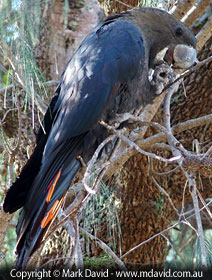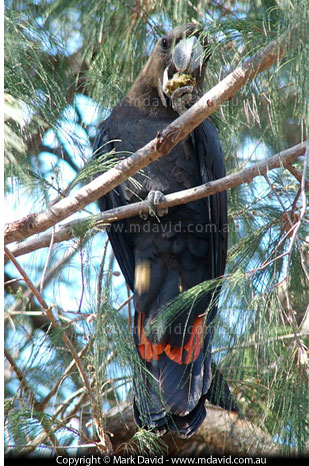
The Glossy Black Cockatoo (Calyptorhynchus lathami) is a handsome bird that feeds on Casuarina seedpods. It therefore needs to have access to good Casuarina supplies if it’s going to stay around.

When a flock of Sulphur-crested Cockatoos moves into your neighbourhood you tend to know about it. Their screeching call is outrageous. Glossy Blacks however, sit calmly in their Casuarina (She-oak) trees cracking seeds open, mostly unnoticed. That’s the clue to finding them. Several times I’ve been in the bush and heard what sounds like someone busy working with a nut cracker nearby. Find the source of the noise in the nearest stand of Casuarina and look up and chances are you’ll see a pair of Glossy Blacks. When I say ‘several times’ it’s probably the same pair of birds I’ve seen on those occasions, because a pair will often settle into an area once they find a good source of food trees.
What do they look like?
This is the smallest of the black cockatoos, which is saying something about just how big the other ones are, because this is still a decent-sized bird (approx. 48cm). First impression is black wings and almost black body, with a flash of red in the male’s tail. The female looks similar but has an irregular yellow blotchy band around its neck and some yellow in the tail. They look a lot like the red-tailed black cockatoo but don’t have a big crest on their head. A familiar stance is one foot holding the branch with the other foot holding the seed. The photos on this page shows this.

Where do you find them?
You’re most likely to find them in Casuarinas or sometimes gum trees in eastern Australia, from Southern Queensland extending down into Victoria. There are also a few on Kangaroo Island, off South Australia. If you’re in the bush and come across a stand of Casuarinas where the ground underneath is thoroughly covered with cracked seeds, there’s a good chance you’ve found a place where a pair of Glossy Blacks feed.
Casuarina
These birds rely on Casuarina for the bulk of their food, and those trees tend not to be considered valuable by many people. Casuarinas burn badly in a bush fire, and this makes Glossy Blacks susceptible to fires too. They like to nest in tree hollows near their food trees, which is a problem because good hollows are becoming more and more rare, as land clearing for housing removes old gum trees and breaks the bush up into isolated patches, which separates the nesting trees from the food trees. Also the declining number of tree hollows is already in great demand by other species.
Some things we can do to help
The first thing is to allow stands of Casuarinas to grow. Also, old gum trees with hollows are extremely important nesting spots for Glossy Blacks and heaps of other native species, so we could value them a lot more too. Even dead trees, if they have decent hollows, are important nesting spots.






